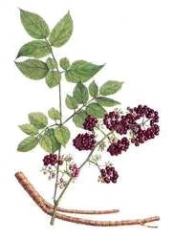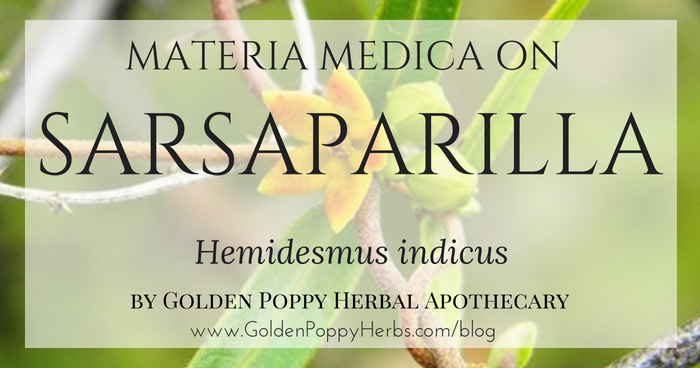EVER WONDERED WHAT SARSAPARILLA IS? DID YOU KNOW THAT THERE ARE AT LEAST TWO DIFFERENT KINDS?
Indian Sarsaparilla is an herb of many faces. Often called "False Sarsaparilla" for its frequent confusion with the American variety.
It is a plant that packs as much punch as it has names. Known originally to the ancient healing tradition of India as “sugandi root,” it also goes by the names Ananta-mula, Anantmoola, Ananthamoola, Anantmula, Upalasari, Gadisugandhi, Gopakanya, Hemidesmus, and White Sariva—and that is in India alone! The multiplicity of nomenclature, however, attests to the popularity and power of this herb, found to be effective in various different societies.
Sugandi is a creeper vine found growing natively all over southern Asia, but it originated in India where it is still often found growing wild as farm north as the Himalayas and as far south as Kerala. It is also known to grow in Malaysia, Indonesia, and Sri Lanka. This ancient healing plant has been transported to all parts of the world and is prized by many horticulturists and practitioners of traditional medicine for its healing properties and aromatic qualities (Acharya et al. 2006).

In the Himalayas, the herb is ground to a coarse powder with dried leaves or seeds of Holy Basil, Bel Fruit or flowers of lotus (such as our 3 Lotus Paste) jasmine and safflower and then burned as a ritual incense. In traditional Tibetan medicine the roots are considered to be a sweet, delicious herb, associated with meditation and trance.
Ayurvedic texts refer to this herb as 'the eternal root' as its root spreads for a long way underground. The roots are called the "symbols of human mind on the earth" and look like little neurons complete with synapses and glias, believed to induce magical-spiritual dreams and help with clarity of mind. The root is said to be useful for all three doshas, balancing a variety of different energetic body types.
In Western science this root has also received attention. There are six major therapeutic uses that have been tested and shown to be effective in Western medicine: anti-inflammatory, diuretic and vulnerary, prevention of miscarriages, improves fertility, and treats syphilis. There is also significant scientific evidence that the root can be used effectively as a treatment for arthritis, asthma, bronchitis, epileptic seizures, high blood pressure, immune disorders, and high stress (Arun et al. 2007)
 Photo Source[/caption]
Photo Source[/caption]
MATERIA MEDICA
Latin Name: Hemidesmus indicus (L.) Schult.
Common Name: Hemidesmus
Synonyms: Indian sarsaparilla, East Indian sarsaparilla
Family: Asclepiadaceae
Parts Used: Root
Habitat: A climbing vine found throughout India
Actions: Alterative Depurative Diaphoretic Immunodepressant
Applications:
- Autoimmune disease
- Rheumatoid arthritis
- Chronic Skin Disorders
- Asthma, bronchitis
Dosage:
- Tincture - 30 - 60 ml per week (1:2)
Cautions:
- The herb is mildly immunosupressant, however it is considered to be very safe and non-toxic
Works Referenced:
- Arun, V., V. Liju, and J. Reena. “Traditional Remedies of Kani Tribes of Kottoor Reserve Forest, Agasthyavanam, Thiruvananthapuram, Kerala.” Indian Journal of Traditional Knowledge, n.d.
- Grieve, M. “Sarsaparilla, Indian.” Botanical.com, 2009. “Hemidesmus Indica Capsules.” La-meddica.com, 2007.“Hemidesmus Indicus.” Wikipedia, 2009.
- Kainthla, R., R. Kashyap, and J. Deopujari. “Effect of Hemidesmus Indicus (Anantmool) Extract on IgG Production and Adenosine Deaminase Activity of Human Lymphocytes in Vitro.” Indian Journal of Pharmacology, 2006.
- Madhu, A., K. Prashanth, and J. Singh. “To Evaluate the Anti-Epileptic Activity of Aqueous Root Extract of Hemidesmus Indicus in Rats.” Archives of the Pharmaceutical Sciences and Research, 2009.
- Pole, S. Ayurvedic Medicine: The Principles of Traditional Practice. Philadelphia: Elsevier: Churchill Livingstone, 2006.
- Prabakan, M., R. Anandan, and T. Devaki. “Protective Effect of Hemidesmus Indicus Against Rifampicin and Isoniazid-induced Hepatotoxicity in Rats.” SciVerse, 2000.
- Rout, S., T. Panda, and N. Mishra. “Ethno-medicinal Plants Used to Cure Different Diseases by Tribals of Mayurbhanj District of North Orissa.” Studies on Ethno-Medicine, 2009.
By Kelly Anne Graves, Masters-degree student intern




